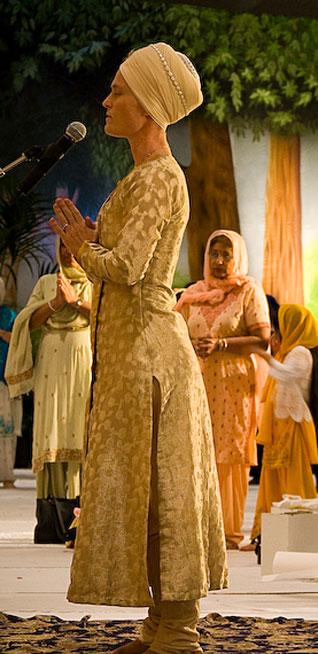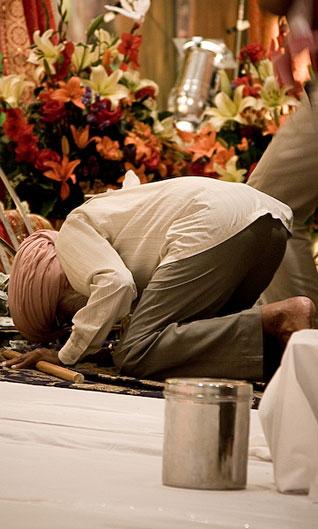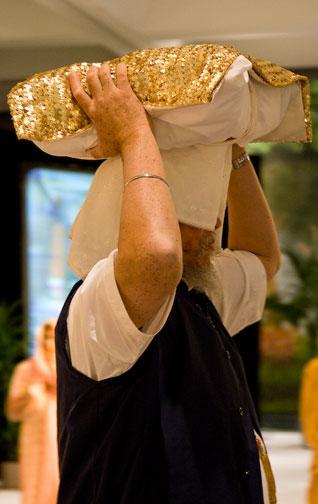History
Through My Eyes...and Lens
by JUDITH QUINONES
On April 6, 2008, I had the novel experience of accompanying my husband to the Vaisakhi celebration held at the Los Angeles Convention Center in California, U.S.A.
He was to accept an award on behalf of Valarie Kaur, a Sikh woman who couldn't be there because she was on tour with her film, Divided We Fall. I was to be the honoree-by-proxy's guest.
I must admit that upon hearing we would be going, I was instantly intimidated. I imagined myself a lone, non-Sikh woman in a stadium-sized complex teeming with tens of thousands of stern-faced men in turbans. I imagined them all staring at me disapprovingly as if to say, "Why are you here? You don't belong with us."
Though I did encounter some of that (a fact to which I will return), it was not the defining aspect of my experience. The experience was much more complex and nuanced, replete with contradictions, questions, revelations, and - in my own Buddhist way - reverence.
When I arrived at the convention center, I felt bemused by the layout of the event: A room full of food, a bazaar, a string of nooks to leave your shoes, and a gurdwara lay-out that was nowhere near the stadium-size I had envisioned.
The bazaar was like a colorful gauntlet of Sikh paraphernalia and, at the height of the day's festivities, hundreds of people ambled about the booths. It buzzed with the energy I remember bazaars buzzing with when I was in India during the summer of 2000.
As it was morning when I arrived, I made my way through quickly and was soon standing barefoot at the entrance of the gurdwara.
Inside was a vibrantly decorated room with a path down the center leading to the altar, upon which lay the Guru Granth Sahib. Behind the Guru were four men with swords upheld, and one woman. As for the sangat, men were sitting to the left of the central path and women to the right. Two stages flanked the central altar, and there was a group of orange-turbaned men chanting kirtan on the left stage.
Outside the two stages were two projection screens; translations of the kirtan currently underway scrolled by calmly. Stretching along the walls were large, free-standing murals depicting natural scenes in vivid greens, browns, and yellows.
A large crowd was gathered on the carpet leading up to the altar. They were making their way slowly toward the Guru to prostrate and make offerings. Lining their path, faux doves hung overhead as if to remind them that theirs should be a path of peace. It was a beautiful scene, and I felt the impulse to enter and explore, but fear stopped me.
My biggest fear was that I would do something ‘wrong', like trespass onto the men's side of the room (even though I had been told it wasn't really trespassing) or approach some sacred implement in a way I shouldn't have.
Underlying that fear, however, was another that I could never in my wildest dreams have anticipated. I was afraid of and angry at the thought of having to cover my head before I could enter. Now, as someone who spent a good part of her graduate career doing ethnography, I was embarrassed to realize that I felt this way.
It was a simple enough thing to do: it was tradition, it was customary, it was a matter of respect. But thus are the small hypocrisies that gnaw at us all.
The angry part of me was countering tradition with, "But I'm not Sikh! Why should I have to cover my head? Can't they just accept me as I am and know that I mean no disrespect?"
In reality, this rash, angry part of me was just a manifestation of the fear beneath. The root of the matter was that I felt, by putting on a headscarf, I was being forced to sublimate part of who I am. I felt like I had to hide the strong, powerful, feminist part of me under that scarf whether I liked it or not.
I was afraid of what I might look like. I was afraid of seeming like less when other people saw at me. I was afraid of what I might be without that part of me. I recoiled from the act until the last possible moment.
Then, I had no choice. I wrapped the scarf around my head, felt myself shrink, and walked into the gurdwara feeling a strange brew of hostility and fascination. I sat on the men's side ... along with my husband and the other amazing women who were there to be honored.
This made me feel better. Even if I could never be fully comfortable with the headscarf on, at least I hadn't sacrificed everything; I was sitting among men.
And, I had come armed with my camera.
I'm not sure if it was the camera or me, but as I continued to sit there, I began to feel the gaze upon me, the one I had imagined from stern-faced men. I don't know whether it was humility, embarrassment, or the drawing upon of old stores of compassion; but my reply was to smile - the warmest most comprehending smile I could muster.
Some of them smiled back, pleasantly surprised and accepting. Others just stared; I might be a gross infection, I might be a sympathetic exoticist. Either way, they weren't going to give me an inch. I won't deny that this affected me, but I took refuge behind my lens.
I began to let go of my own baggage and focus on what I felt obliged to do, which was to photograph every level of what I was seeing in the most genuine way possible, in way that would capture the spirit of the day. Once I started doing that, the headscarf and stares grew lighter; I felt my power return.
Part of what I saw around me was division. Men divided from women, and Indian Sikhs divided from non-Indian Sikhs. This surprised me, although perhaps it shouldn't have since most of us have trouble living up to what we say we believe in, including myself.
But I digress ... I had read that according to the Sikh faith, men and women are equal. Yet, they weren't sitting together, and the podium from which all addresses were made was on the men's side. I had read that, according to the Guru, there is only Oneness. We are all One, we belong to One. Yet, I didn't see a lot of interaction among Sikhs across racial lines.
Indian Sikhs socialized and sat with other Indian Sikhs, and non-Indian Sikhs socialized and sat with other non-Indian Sikhs. There were minor exceptions, of course, but I am speaking in overview.
To confound these observations of sex and race even more, all of the award honorees of the day were women (my husband, of course, representing a woman), several administrators of the day's events were non-Indian Sikh women, and non-Indian Sikh men and women were integral to the closing ceremony before the Guru Granth Sahib was reverentially carried out for the nagar kirtan.
These observations spawned a host of questions: Why do these divisions exist in a faith that speaks of Oneness and equality? How to traditional Indian Sikh men feel about non-Indian Sikh women being in administrative positions? How do Indian Sikh women feel when they see the roles non-Indian Sikh women assume? Why don't Indian Sikhs and non-Indian Sikhs interact more if they're all here for the same reason and they all worship the same faith? Are the boundaries of acceptable behavior different for Indian Sikhs and non-Indian Sikhs?
Finally, where is my place in all this, as a Costa Rican American woman practitioner of Tibetan Buddhism?
The answer to all of those questions,with the exception of the last is, I don't know. I'm not sure anyone does or could. As for the last question, the answer was, My place is right here. By whatever causes and conditions, I came to be there on that day to see what I saw, meet whom I met, feel what I felt, and document what I did. And I believe that is exactly where I belonged.
I belonged in that place where, despite the above observations, there were plenty more positive ones. I saw families come together to share time and devotion. I saw thousands of people of every age get down on their hands and knees to revere their Guru, just as I have done so many times to revere mine. I saw and heard people sing sacred verses.
Yes, I belonged in that place where every fear, contradiction and division I touched upon melted away as soon as I accepted that the most important thing was my relationship to the Guru.
When I looked at up at the altar and thought, "I know you; by another way, but I know you," I felt at peace. What I saw then was beautiful. It was One, even if we didn't all know it yet.
If part of the spirit behind Vaisakhi is commemoration of the birth of the Khalsa, then perhaps such pure moments are the most profound offering we could hope to give, the most profound gift we could hope to receive.
It is what I left the day with, and what I leave you with now: Waheguru ji ka Khalsa, Waheguru ji ki fateh!
[April 26, 2008]
Conversation about this article
1: Parveen Kaur Dhatt (Brampton, Canada), April 30, 2008, 8:56 PM.
I have always wondered how non-Sikhs feel when entering a gurdwara and it is refreshing to read an objective article through the lens of an "other". While all of the world's religions have a unique core of universal values, sometimes cultural practices overshadow the religious one. The Sikhs are no different in this regard; centuries-old traditions seem more cemented in the daily routine. Segregation of the sexes is done for practical reasons, however this does not imply a power imbalance between men and women, both sit side by side in the presence of the Guru. It allows the devotees to focus and meditate on the Guru without the distraction of the other gender; others may disagree but we have to remember that most of us are at different levels of assimilating religiously. Guru Nanak was the first 'feminist', and therefore covering one's head is not bound by gender, both men and women are expected to honour this.
2: Judith Quinones (Los Angeles, U.S.A.), April 30, 2008, 9:07 PM.
I just wanted to let everyone know that fortunately I was able to read all of your comments before they were lost. Thank you all so much for accepting this piece here and for responding to it thoughtfully. I was grateful to learn from each of your perspectives.
3: Inni Kaur (Fairfield, CT, U.S.A.), April 30, 2008, 9:41 PM.
Judith: While you did witness a degree of divide between the Indian-Sikhs and the non-Indian Sikhs, I hope you also experienced the tremendous force that unites us - "our love for The Guru." By Guru's Grace, when we meet again, may you witness: Not a Indian Sikh, Not a Non-Indian Sikh, Just A Guru's Sikh. Meeting you was a 'breath of fresh air. ...'Till we meet again!
4: Gurmeet Kaur (Atlanta, U.S.A.), May 01, 2008, 12:50 PM.
Dear Judith, you are a skilled photographer; and an even better writer. I loved reading this article because it reminds me of my questioning mind when I see similar discrepancies. But ultimately, like Inni Kaur ji said, once you are touched by grace, you see only love for the Guru and the Oneness that binds us. It releases the anguish of the questioning mind and teaches one to accept the imperfections and rise above them. I am glad you were able to ultimately see that oneness beyond the stern faces, beyond the weight of the scarves, and the seating arrangements and even gladder that you decided to share it with us.
5: Judith Quinones (Los Angeles, U.S.A.), May 03, 2008, 1:26 PM.
Inni, I did indeed experience that united force. What I remember most about that day was the sense of Oneness I felt by the end. It was very humbling, warm and beautiful. I feel connected to all of you more because of it.
6: Tejwant (U.S.A.), May 04, 2008, 2:31 PM.
Judith, your initial reluctance, reservation and bias prove that we are all capable of progressing to a second impression provided we are not myopic enough to obstinately stick to our first and only one; especially for those who can detect the uniqueness through their camera lens, which has led you to a kind of metamorphosis of your initial thoughts into something vibrantly beautiful, something different whose goodness is worth embracing, because of its universal message: one that leads us to become warriors of peace and justice for all, which Sikhi calls the Sant-Sipahis. Welcome to the Peace Warriors Corps.
7: B.Kaur (New Zealand), May 05, 2008, 6:33 AM.
Absolutely a wonderful piece of writing. I have always admired the Sikhs of the diaspora, including the so-called non-Punjabi ones: they have had to give so much more to being and becoming a Sikh!
8: Atika Khurana (Columbus, Ohio, U.S.A.), May 10, 2008, 10:42 AM.
God is one, God is universal and God is omnipresent. This is my humble understanding of what constitutes the most fundamental principle of Sikhism. Every religion is a social construction and, just like with any other religion, the contemporary religious practices in Sikhism have also been shaped by the indigenous socio-cultural forces operating since the time of its inception. I believe that a person's spiritual awareness and desire to connect can easily transcend these man-made boundaries. As I view it, all religions are, simply put, different channels leading to the same ultimate goal (of self-discovery). I am glad that you were able to dispel the extrinsic socio-cultural barriers and could connect to the Guru at a deeper, more profound level.
9: Jaswinder Singh (Toronto), July 07, 2008, 3:21 PM.
Just to want to say that in Punjab, men and women do share the same area. They don't sit on opposite sides, as they do here in Canada. I was at surprised to see this when I first came here and visited a gurdwara. This is not accoring to gurmat. And it's one of the unfortunate things that have somehow crept into or religion in recent years.






